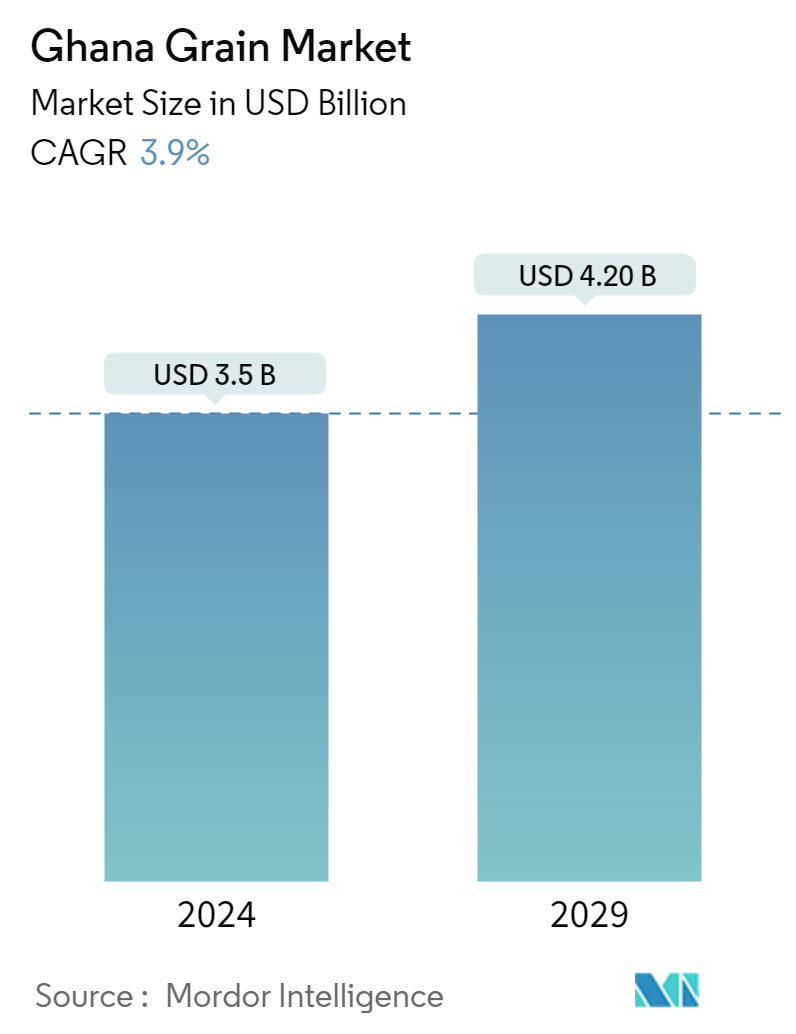Market Size of Ghana Grain Industry

| Study Period | 2019 - 2029 |
| Base Year For Estimation | 2023 |
| Forecast Data Period | 2024 - 2029 |
| Market Size (2024) | USD 3.5 Billion |
| Market Size (2029) | USD 4.20 Billion |
| CAGR (2024 - 2029) | 3.90 % |
Ghana Grain Market Analysis
The Ghana Grain Market size is estimated at USD 3.5 billion in 2024, and is expected to reach USD 4.20 billion by 2029, growing at a CAGR of 3.9% during the forecast period (2024-2029).
- The Ghanaian grain market primarily serves domestic needs, encompassing cereals, pulses, and oilseeds. Ghana relies on imports to meet its cereal demands, highlighting its lack of self-sufficiency in this sector. Locally produced cereals, notably maize and rice, play a pivotal role in traditional Ghanaian cuisine. For example, Kenkey, a staple dish made from corn dough, is widely enjoyed, often paired with pepper sauce and fried fish. Similarly, rice's growing prominence in the Ghanaian diet is attributed to its convenience and evolving tastes.
- As per FAO, maize production reached 3.3 million metric tons in 2022. Following maize, rice and sorghum were cultivated at 1,283.0 thousand metric tons and 401.5 thousand metric tons, respectively. Beans and peas dominated the pulse cultivation, while groundnut led in oilseed production. In February 2022, the Ministry of Food and Agriculture (MoFA) introduced a tech-driven initiative aimed at enhancing rice production. This project, focusing on technological advancements and quality control in post-harvest processes, aims for rice self-sufficiency by 2025.
- The expanding middle class in Ghana is shifting from traditional staples like cassava and yam to convenience foods based on rice and maize, signaling a growing market for local grain producers. Yet, challenges loom: climate change threats, insufficient financial support, and limited extension services for small-scale farmers could hinder the grain market's growth in the coming years.
Ghana Grain Industry Segmentation
Grain is the harvested seed of grasses, such as wheat, oats, rice, corn, etc. The Ghana Grain Market Report Includes Production Analysis (Volume), Consumption Analysis (Value and Volume), Export Analysis (Value and Volume), Import Analysis (Value and Volume), and Price Trend Analysis. The Market is Segmented by Crop Type (Maize, Millet, Sorghum, and Rice). The report offers market size and forecast based on value (USD) and volume (metric tons) for the above segments.
| Crop type (Production Analysis by Volume, Consumption Analysis by Volume and Value, Import Analysis by Volume and Value, Export Analysis by Volume and Value, and Price Trend Analysis) | |
| Maize | |
| Millet | |
| Sorghum | |
| Rice |
Ghana Grain Market Size Summary
The Ghanaian grain market is primarily driven by domestic demand, encompassing cereals, pulses, and oilseeds. Despite significant local production, Ghana relies on imports to meet its cereal needs, with maize and rice being the most consumed due to their integral role in traditional cuisine. The market is characterized by a shift in consumer preferences, with a growing middle class favoring rice and maize-based convenience foods over traditional starches. This trend presents opportunities for local grain producers, although challenges such as climate change and insufficient support for small-scale farmers pose potential constraints. Government initiatives like the Planting for Food and Jobs Programme aim to enhance domestic production and reduce reliance on imports, contributing to gradual market growth.
Maize stands out as the most crucial cereal crop in Ghana, both in terms of consumption and production volume. It serves as a staple food and is vital for poultry feed and the brewing industry. The government has implemented structural changes and partnerships to boost grain production, evidenced by increased fertilizer usage and improved seed distribution. These efforts are expected to enhance productivity and food security, reducing the need for imports. Additionally, initiatives like the 'One District, One Factory' program and the Mastercard Foundation's 'Grains for Growth' project aim to strengthen the grain supply chain, creating job opportunities and supporting economic development in the sector.
Ghana Grain Market Size - Table of Contents
-
1. MARKET DYNAMICS
-
1.1 Market Overview
-
1.2 Market Drivers
-
1.2.1 Rising Initiatives Supporting the Market Growth
-
1.2.2 Increased Focus on Sustainable and Green Farming
-
1.2.3 Opportunities Export Market
-
-
1.3 Market Restraints
-
1.3.1 Lack of Efficient Irrigation Facilities
-
1.3.2 Threat of Climate Change
-
-
-
2. MARKET SEGMENTATION
-
2.1 Crop type (Production Analysis by Volume, Consumption Analysis by Volume and Value, Import Analysis by Volume and Value, Export Analysis by Volume and Value, and Price Trend Analysis)
-
2.1.1 Maize
-
2.1.2 Millet
-
2.1.3 Sorghum
-
2.1.4 Rice
-
-
Ghana Grain Market Size FAQs
How big is the Ghana Grain Market?
The Ghana Grain Market size is expected to reach USD 3.5 billion in 2024 and grow at a CAGR of 3.9% to reach USD 4.20 billion by 2029.
What is the current Ghana Grain Market size?
In 2024, the Ghana Grain Market size is expected to reach USD 3.5 billion.

